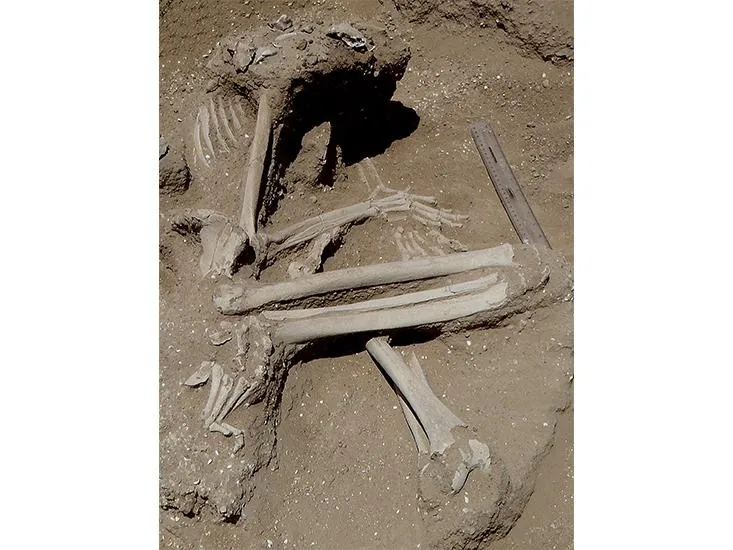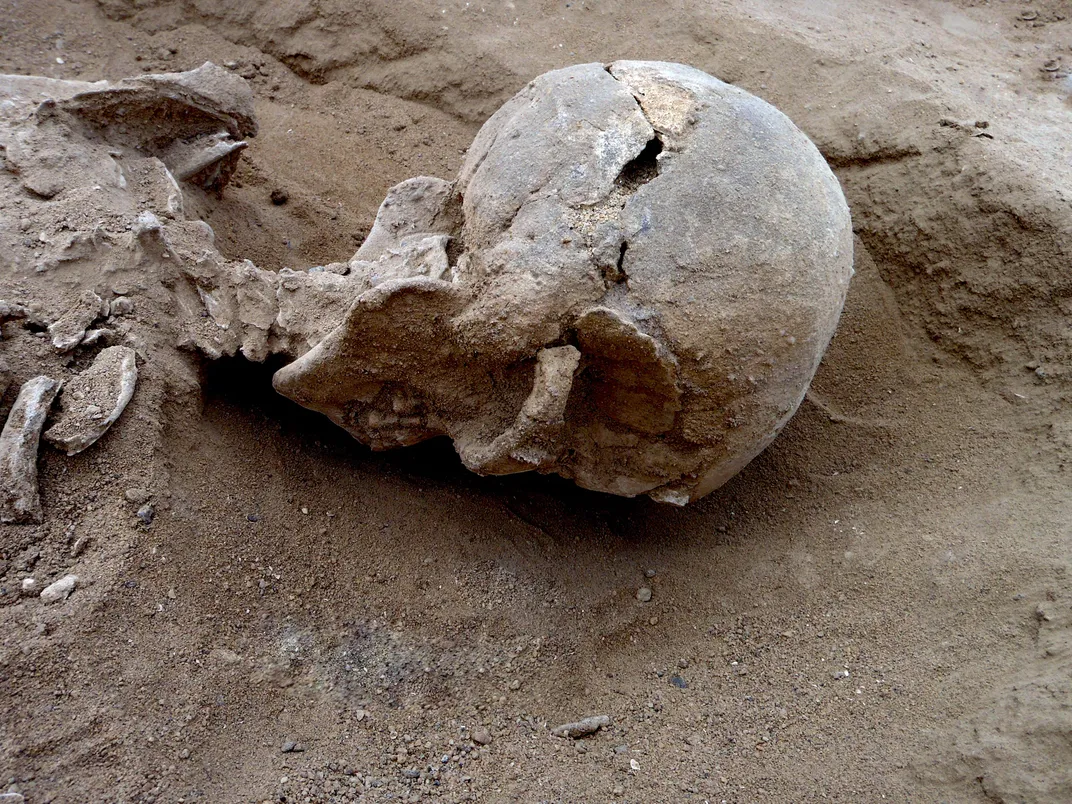An Ancient, Brutal Massacre May Be the Earliest Evidence of War
Even nomadic hunter-gatherers engaged in deliberate mass killings 10,000 years ago
/https://tf-cmsv2-smithsonianmag-media.s3.amazonaws.com/filer/71/ea/71eabd2a-83d6-4f0c-a9cd-d30e012f04ae/war-skull.jpg)
Skulls smashed by blunt force, bodies pin-cushioned by projectile points and hapless victims—including a pregnant woman—abused with their hands bound before receiving the fatal coup de grâce.
This violent tableau resembles something from the darker side of modern warfare. But it instead describes the grizzly demise of a group of African hunter-gatherers some 10,000 years ago. They are the victims of the earliest scientifically dated evidence for human group conflict—a precursor to what we now know as war.
The battered skeletons at Nataruk, west of Kenya's Lake Turkana, serve as sobering evidence that such brutal behavior occurred among nomadic peoples, long before more settled human societies arose. They also provide poignant clues that could help answer questions that have long plagued humanity: Why do we go to war, and where did our all too common practice of group violence originate?
"The injuries suffered by the people of Nataruk—men and women, pregnant or not, young and old—shock for their mercilessness," says Marta Mirazon Lahr of the University of Cambridge, who co-authored the study published today in the journal Nature. Still, she notes, "what we see at the prehistoric site of Nataruk is no different from the fights, wars and conquests that shaped so much of our history, and indeed sadly continue to shape our lives.”
Nataruk's prehistoric killers did not bury their victims' bodies. Instead their remains were preserved after being submerged in a now dried lagoon, near the lake shore where they lived their final, terrifying moments during the wetter period of the late Pleistocene to early Holocene.
Researchers discovered the bones in 2012, identifying at least 27 individuals on the edge of a depression. The fossilized bodies were dated by radiocarbon dating and other techniques, as well as from samples of the shells and sediment surrounding them, to approximately 9,500 to 10,500 years ago.
It's not clear that anyone was spared at the Nataruk massacre. Of the 27 individuals found, eight were male and eight female, with five adults of unknown gender. The site also contained the partial remains of six children. Twelve of the skeletons were in a relatively complete state, and ten of those showed very clear evidence that they had met a violent end.
In the paper, the researchers describe “extreme blunt-force trauma to crania and cheekbones, broken hands, knees and ribs, arrow lesions to the neck, and stone projectile tips lodged in the skull and thorax of two men.” Four of them, including a late-term pregnant woman, appear to have had their hands bound.

The murderers' motives are lost in the mists of time, but there are some plausible interpretations that could challenge conventional ideas about why people go to war.
Warfare has often been associated with more advanced, sedentary societies that control territory and resources, farm extensively, store the foods they produce and develop social structures in which people exercise power over group actions. Conflict erupts between such groups when one wants what the other possesses.
The bodies at Nataruk provide evidence that these conditions aren't necessary for warfare, because the hunter-gatherers of the time lived a far simpler lifestyle. Yet the killings have the hallmarks of a planned attack rather than a violent chance encounter.
The killers carried weapons they wouldn't have used for hunting and fishing, Mirazon Lahr notes, including clubs of various sizes and a combination of close-proximity weapons like knives and distance weapons, including the arrow projectiles she calls a hallmark of inter-group conflict.
“This suggests premeditation and planning,” Mirazon Lahr notes. Other, isolated examples of period violence have previously been found in the area, and those featured projectiles crafted of obsidian, which is rare in the area but also seen in the Nataruk wounds. This suggests that the attackers may have been from another area, and that multiple attacks were likely a feature of life at the time.
“This implies that the resources the people of Nataruk had at the time were valuable and worth fighting for, whether it was water, dried meat or fish, gathered nuts or indeed women and children. This shows that two of the conditions associated with warfare among settled societies—control of territory and resources—were probably the same for these hunter-gatherers, and that we have underestimated their role in prehistory.”
“This work is exciting and it suggests, at least to me, that this type behavior has deeper evolutionary roots,” says Luke Glowacki, an anthropologist with Harvard University's Department of Human Evolutionary Biology.
We aren't the only species to engage in such behavior, he adds. Our closest relatives, chimpanzees, regularly engage in lethal attacks. “To deliberately stalk and kill members of other groups, as the chimps do, that alone is very suggestive of an evolutionary basis for warfare,” he says.

But evidence to support or refute such theories has been thin on the ground. The sparse previous examples of prehistoric violence can be interpreted as individual acts of aggression, like a 430,000-year-old murder victim found in Spain last year. That makes Nataruk a valuable data point in the fossil record.
More clues may be found among the behaviors of living peoples. Researchers can make inferences about conflict among early human hunter-gatherers by studying their closest living parallels, groups like the San of southern Africa. But such comparisons are tenuous, Glowacki notes.
“The San are very different from our ancestors. They live in nations, they are surrounded by pastoralists and they go to markets. That limits the utility of making inferences about our own past.” Still there are other suggestions that resource competition isn't always at the root of human violence.
“In New Guinea for example, where there are abundant resources and land, you've traditionally seen very intense warfare driven by tribal and status dynamics,” Glowacki says. “We don't have any way of knowing if that was involved at Nataruk.”
And whatever its roots, warfare persists even in the same region of Africa: “This is still an area with a lot of intense violence in the 21st century,” Glowacki notes. “It was eye-opening from my perspective that the first really good fossil evidence for warfare among ancient hunter-gatherers comes from a place where there is still, today, this ongoing intergroup violence.”
But, the authors point out, there is another aspect of human behavior that has also stood the test of time.
“We should also not forget that humans, uniquely in the animal world, are also capable of extraordinary acts of altruism, compassion and caring,” Mirazon Lahr says. “Clearly both are part of our nature.”